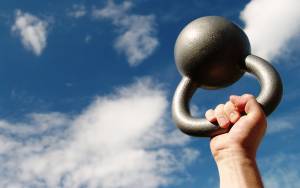Sometimes a shoulder injury isn’t just a shoulder injury. What if your grip was playing a role? And why wouldn’t it? In CrossFit, we grip everything! The barbell, the rig, the rower, the jump rope, the kettlebell, the dumbbell… We cannot ignore how we grip and the influence this has on shoulder health. Proper and strong grip has it been shown to improve rotator cuff activity and may actually play an important role in injury prevention and recovery.
There are several ways in which grip influences the shoulder:
1. There is a neurological connection between grip and the rotator cuff.
It is thought that there is what we call “anticipatory stability” in the upper extremity when we grip. Simply, your brain knows that when you grip something, it now needs to turn on the muscles of the shoulder in order for the arm to function properly and avoid injury. Essentially, your shoulder will be better prepared to handle the stress you are about to place on it.
Therefore, if you are gripping the bar for a pull-up, or about to snatch a bar off the ground, it is important that you are gripping correctly. For barbell work this is a HOOKGRIP! For the rig, this means we like the thumb under the bar so that you are in a standard overhead grip. Note: many athletes have fought me on the thumb wrapped position with the pull-ups, bar MUs, etc., but give it a go after reading this.
2. A firm and proper grip increases neural drive throughout the system.
Increased neural drive means increased readiness for movement execution. Some have called this “irradiation”, or a spreading and increasing strength of response. We are referring to an adaptation in which the nervous system is more effectively and efficiently communicating with the muscles and is able to produce greater force despite the muscle being the same size. When we grip, we increase neural drive. This is vital to shoulder health. If one did not prepare the system for the load they were about to place on the shoulders and just willy-nilly grabbed the barbell, the could be setting themselves up for injury as the neuromuscular system may not have been prepared for that load. Not just in training and underlying strength, but in that moment!
3. Grip strength helps to balance which muscles in the shoulder we are using.
As mentioned, gripping correctly helps to activate the rotator cuff muscles, but it also decreases the activity of the middle and anterior deltoid. This is really important for patients who have shoulder impingement. In a healthy shoulder joint, the deltoid and the rotator cuff work together to form a force couple. A force couple is a system that exerts a resultant movement, but no resultant force. Two equal and opposite forces exert a purely rotational force. In a force couple, force generated by one muscle (the primary agonist) requires the activation of an antagonistic (opposing) muscle so that a dislocating force does not result.
This image is from a great blog written by Dr. Dan Pope and is used here in this piece because of its beautiful simplicity.
The rotator cuff muscles act as a force couple with each other and the deltoid. Think of it this way: the rotator cuff’s job is to center the humeral head (ball) into the glenoid fossa (socket). In patients who have impingement, the deltoid has become dominant and the rotator cuff cannot perform this stabilizing action well. Therefore, the ball drifts superiorly (up) and causes a pinching to occur between the two bones.
Why do we care about a force couple??? A force couple balances the vectors (forces) produced by each muscle group and gives balance to the joint. Balance in a joint creates stability. Stability is what prevents injury when the joint is loaded and taxed.
So HOW do we train grip?
We have lots of options here:
mindful/intentional gripping of a barbell or pull-up bar
farmers carries
grip strengthening tools such as the thera-bar or flex-bar
endurance training for grip (long holds on the bar, rowing, long holds on pull-up bar, etc.)
Below, two of my favorite pointers for grip strength and general arm health:
***
1. Practice gripping in both a pronated (palms down) and a supinated (palms up) position
In CrossFit, we do virtually everything with our palms down and this places an asymmetrical stress on the upper extremity tissues. Think about it: rowing, pull-ups, deadlifts, pulling any bar off the floor for that matter, KB swings, push ups, etc. As CrossFit athletes we are very imbalanced in our forearm musculature.
This in itself can lead to hand, wrist, elbow and shoulder problems. So, toss in biceps curls and chin-ups here and there.
2. Bottoms-Up Kettlebell training
Bottoms-up training has great benefits, from improving strength, size, athletic performance, mental focus, anaerobic conditioning, posture, and breathing strategies. Hold a kettlebell with the bell up, handle down. The instability requires you to recruit additional muscle fibers and motor units to control the load.
Bottoms-up training is simple. Rather than holding a kettlebell with the bell hanging below the hand, flip it upside down so the heavy portion sits above the handle. This forces you to recruit additional muscle fibers and motor units. This method improves strength, performance, and movement mechanics. It even enhances joint integrity.
Try this exercise posted on T-Nation. Unilateral KB bottoms-up shoulder press:
https://www.t-nation.com/training/weirdest-training-method-that-works
Good luck and remember to get checked out by your physical therapist to find out more about how to improve your grip-shoulder connection. Contact www.arrowptseattle.com for questions, comments, or concerns!!










